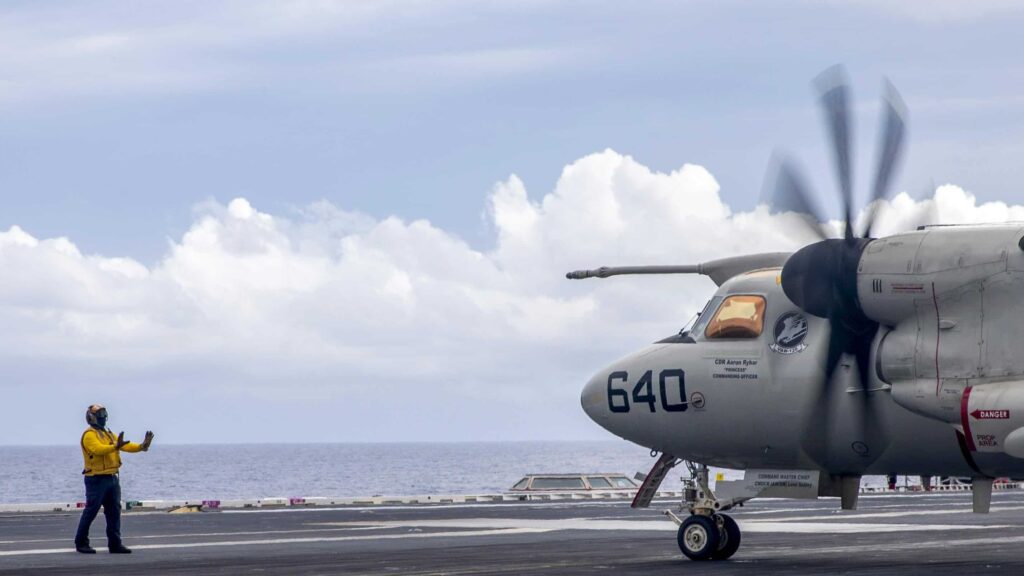
The first two E-2D Advanced Hawkeye Distributed Readiness Trainers (D-DRT) successfully completed Fleet Mission Testing at NAS Norfolk, Virginia, and are officially deemed Ready for Training (RFT). Delivered five months ahead of schedule, these are the first Delta System Software Configuration 3 (DSSC-3) aircrew trainers for the fleet.
The trainers provide carrier airborne early warning pilots and naval flight officers the ability to train on a low cost, medium fidelity device that enables a full E-2D crew of two pilots and three flight officers to practice executing an entire suite of intermediate and advanced tactics including mission-critical coordination skills. The two D-DRT devices are also able to connect and operate together, simulating dual E-2D training scenarios that require such battlespace management to simulate tactics and procedures in complex scenarios.
According to Capt. Chris “Mullet” Hulitt, Airborne Command, Control and Logistics Wing (ACCLOGWING) deputy commodore, “The D-DRT provides a unique capability above other E-2D training devices to support ‘reps and sets’ in execution-based advanced integrated tactical skills, where a medium fidelity device meets the training need. The improved operating system gives instructors the ability to push aircrew through more advanced and complex tactical scenarios.”
The devices utilize touch screen technology to simulate weapons system controls, and have the added advantage of using mostly commercial-off-the shelf hardware and software to provide a less complex system that is easier and less expensive to maintain, thereby greatly improving reliability and reducing lifecycle costs.
The trainers allow the fleet to meet growing demands of increased complex tactics, as well as the augmented need to train in a distributed environment with other type model series aircraft in the Air Wing as part of the Carrier Strike Group. This also allows E-2D crews to train with U.S. Joint Forces and participate in fleet exercises such as Fleet Synthetic Training and Virtual Flag.
The devices are scheduled to be connected to the Navy Continuous Training Environment Network in fiscal year 2024, when a new training building is scheduled to be complete at NAS Norfolk.
During the D-DRT production, various fleet representatives from the Airborne Command & Control and Logistics Weapons School, Carrier Airborne Early Warning Weapons School/Naval Aviation Warfighting Development Center, the Fleet Replacement Squadron (VAW) 120 and test community were brought in for demonstrations to provide feedback on performance.
The initial production contract was awarded in fiscal year 2018 for five full D-DRT systems, which included two at NAS Norfolk, two at Marine Corps Air Station (MCAS) Iwakuni, Japan in support of Carrier Air Wing (CVW) 5 and Airborne Command & Control Squadron (VAW) 125.
“These devices prove that with exceptional government-industry cooperation, coordination and communication, these types of efforts can be accomplished in a fraction of normal acquisition time from contract award to delivery,” said David Adams, E-2/C-2 Training Systems Integrated Product Team Lead with the E-2/C-2 Airborne Command and Control Systems Program Office (PMA-231).
The next two D-DRT systems have already been shipped to MCAS Iwakuni and are currently in the build phase by industry partner’s on-site assembly teams inside the E-2D Training Wing of the CVW-5 training complex.
“Bottom line, it is the right training aid for E-2D warfighters to become highly proficient in the skills that are necessary for us to have to win in the high end fight, in a complementary role with our other training devices,” said Hulitt.
PMA-231’s mission is to develop, acquire and sustain unmatched carrier-based airborne command, control, and logistics aircraft with the E-2C Hawkeye, E-2D Advanced Hawkeye and C-2A Greyhound.












